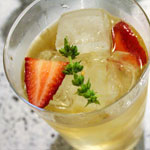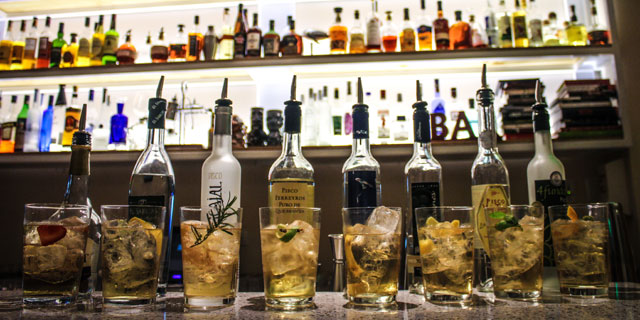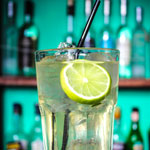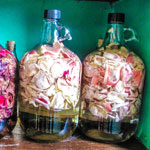As the warm weather approaches in the Southern Hemisphere so begins the season for refreshing cocktails. While many routinely consider the pisco sour as the expected go-to drink in Peru, most Peruvians are actually drinking a completely different alcoholic beast: Chilcano de Pisco, or for short, chilcano.
It’s simple, it’s refreshing, it’s a solid drinkable cocktail that’s easy to prepare and rarely fails. Made from a winning brew of pisco, ginger ale, bitters, and lime juice, the chilcano might just be your gateway drug to start a long love affair with pisco.
There are several different tales of how the chilcano came to be one of the most emblematic drinks in Peru. Most attribute the origins back to the late 19th century, when an influx of Italian immigrants who settled in Peru began swapping their household grappa, and preferred drink the “Buon Giorno”, for a replacement made with the grape brandy sourced locally, pisco. Another (less probably) theory claims that the drink was invented in the city of Chilca by a bartender with the last name Cano.
Although the chilcano (which shares the same name with a beloved fish head, lime, and ají soup) was a favorite aperitif during the 1950s in tabernas, picanterías, and huariques across the country, it’s cool kid status only recently made a big comeback.
“In the past five years everyone started to drink chilcanos again,” Iván de los Rios, star bartender and drink consultant known for his superior mixing skills, told TLK. “This cocktail is generally consumed during lunch hours as an aperitivo, or at night as a proper party drink.”
Next, how to make your own… [pagebreak]
De los Rios, under the eye of chef and owner Héctor Solís, designed the drink menu at La Picantería, a buzzing lunchtime cantina in Lima’s Surquillo neighborhood that specializes in chilcanos. What makes La Picantería’s chilcano reign supreme? It is not served in a traditional long drink or highball glass, and instead it’s put in a 20 ouncer (about 1/2 liter) – a tradition inspired by Lima’s picanterías in the 1960s.
“We serve the chilcano in a big glass to support the Peruvian notion of generosity,” de los Rios said continuing to add, “people who tend to drink pisco, and the chilcano, are the same people who like to drink well and appreciate the art of a good cocktail.”
La Picantería’s bar uniquely boasts chilcanos de pisco that have been infused with a variety of herbs, fruits, spices and even flower petals, including roses, jasmine, daisies and lilies, and also features local fruits like camu camu and guinda.
Over at Casa Moreyra, head bartender Aaron Díaz, of Astrid y Gastón’s La Barra, tried over 120 brands of pisco to create his chilcano menu. Instead of using an infused pisco, Díaz prefers to keep it classic and simple.
“We serve only eight chilcanos, each drink follows the exact same recipe, and we just change the pisco grape and aromatic,” Díaz explained. Diaz meticulously mixed and matched the different pisco grapes before settling on his final eight selection: Mollar pisco with cilantro and grapefruit zest; Moscatel pisco with ginger cubes and pineapple skin; Italia pisco with fennel flower and orange zest; Torontel pisco with pineapple cube and lime zest; Uvina pisco with rosemary and tangerine zest; Albilla pisco with spearmint and lime; and Quebranta pisco with Szechuan pepper and lime. Díaz’s preferred blend? “I like the Uva Negra pisco with basil flower and strawberry the best,” he told us.
Next, mix up your chilcano de piscos… [pagebreak]
- 2 ounces pisco
- 2 drops Angostura bitters
- 1/4 lime, juiced
- ginger ale
- 2 ounces rose petal pisco
- 2 drops Angostura bitters
- 1/4 lime, juiced
- ginger ale
- rose petals and lime twist, for garnish
Basil Flower and Strawberry Chilcano
- 1 3/4 ounce Uva Negra Pisco
- 150 ml Britvic Ginger Ale
- 2 drops bitters
- 2 sprays lime juice
- basil flower
- sliced strawberry




![Making Mealtime Matter with La Familia: Easy Sofrito [Video]](https://thelatinkitchen.com/wp-content/uploads/2015/10/sofrito-shutterstock__0-500x383.jpg)
![Easy Latin Smoothies: Goji Berry Smoothie [Video]](https://thelatinkitchen.com/wp-content/uploads/2015/12/goji_berry-shutterstock_-500x383.jpg)
















![Fun and Fast Recipes: Fiesta Cabbage Salad [Video]](https://thelatinkitchen.com/wp-content/uploads/2015/11/fiesta_cabbage_slaw-shutterstock_-500x383.jpg)









